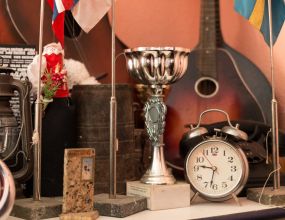
Prvi Svjetski kongres Roma bio je ključan trenutak u povijesti Roma, s usvajanjem romske zastave i himne “Gelem, gelem”. Kongres je potaknuo kulturni ponos, jedinstvo i prepoznavanje romskog identiteta, postavljajući temelje nacionalnom pokretu Roma.
Prijevod: Anna Krainova
Prvi svjetski kongres Roma održan je u Londonu 1971. godine, i to je bio važan događaj za cijeli romski narod. Na Kongresu se raspravljalo o zaštiti prava Roma, borbi protiv diskriminacije i stereotipa, očuvanju kulturne baštine i integraciji Roma u društvo. Na području kulture odlučeno je da se romski glazbeni i plesni festivali redovito održavaju, a uz to se smatralo prikladnim prikupljati i popularizirati romske price i pjesme.
U okviru Kongresa također je bilo važno odobriti simbole romskog naroda: zastavu i himnu. Odlučeno je da se zastava sastoji od dva dijela – plavog gore, koji simbolizira nebo, i zelenog dolje, koji simbolizira zemlju, a u središtu će biti kotač koji odražava kretanje/putovanja. Za himnu je izabrana pjesma "Đelem, đelem" (druge varijante pisanja su: "Dzelem, dzelem", "Gyelem, gyelem", "Gelem, gelem" i sl.), koja, u svojoj vrsti, nije samo pjesma, već odraz kulture i povijesti Roma. Uvođenje ova dva simbola, zajedno s aktivnostima i organizacijama koje su pridonijele njihovom stvaranju, pokrenulo je jasan, uočljiv i glasan izraz ideja koji je stekao priznanje kao nacionalni romski pokret. Himna i drugi nacionalni atributi oblik su izražavanja pripadnosti određenoj nacionalnoj (etničkoj) skupini, što pridonosi stvaranju osjećaja zajedništva. Zato je stvaranje himne i drugih nacionalnih atributa veliki i važan korak prema izgradnji identiteta.
Tekst himne napisao je Žarko Jovanović, romski glazbenik i skladatelj koji je tijekom Drugog svjetskog kongresa Roma imenovan "ministrom romske kulture", a neki izvori među autorima spominju i svirača tambure Miloša (njegovo prezime nije poznato). Patnje romskog naroda kao rezultat Porajmosa (genocida nad romskim narodom) postale su jedna od glavnih tema pjesme. Žarko Jovanović je bio zatvorenik tri koncentracijska logora, izgubio je gotovo cijelu svoju obitelj u Porajmosu, a zatim se pridružio partizanima. Tekst pjesme spominje masakre Roma koje je provela Crna legija (borbena formacija ustaških snaga odgovorna za vrlo velik broj ratnih zločina počinjenih tijekom Drugog svjetskog rata u Hrvatskoj i Bosni i Hercegovini):
Sas wie man yeck barie familia, Jednom sam imao veliku obitelj,
Moodardas la ay Calie Legia. ali Crna legija ju je uništila.
Tekst pjesme ne samo da govori o poteškoćama života Roma, već i poziva na ujedinjenje Roma širom svijeta:
Awen mansa sa loomniacay Roma, Pođi sa mnom, Romi iz cijelog svijeta,
Ky pootardilay ay Romanay droma. Romima su se otvorile ceste.
Acay wriama, oostie Rom acana, Vrijeme je, ustanite, Romi, sada,
Amen cootasa misto Ky cayrasa. Uzdignut ćemo se ako djelujemo.
Prvi redak pjesme "Đelem, đelem"prevodi se kao" išao sam, išao sam dugim cestama", što se također odnosi na povijest i putovanja, lutanja i progone romskog naroda. Tekstovi se uvelike razlikuju od regije do regije i od izvođača do izvođača, ali prvi stih i refren koji se pojavljuju u svakoj verziji smatraju se kanonskim. Tužna i srčana melodija, kao i tekst, govori o tome koliko je teška bila povijest romskog naroda.
Postoje različite verzije podrijetla melodije "Đelem, đelem". Poznato je da je pjesma bila popularna među Romima i prije nego što je postala službena himna. 1967.godine pojavila se u filmu "Skupljači perja" redatelja Aleksandra Petrovića. I film i pjesma korištena u njemu postali su popularni i privukli široku pozornost javnosti.
Pjesma “Đelem, đelem" postala je simbol jedinstva romskog naroda i njegove borbe za priznanje, jednakost i očuvanje kulturnih tradicija. To je svojevrsna himna za sve Rome, izražavajući njihovu povijest, ponos i želju za pravdom.
Prvi svjetski kongres Roma bio je prekretnica u povijesti romskog naroda. Stvaranje kulturnih simbola poput himne i zastave postalo je ključna točka koja će okupiti romski narod i predstavljati ga na svjetskoj pozornici. Himna " Đelem, đelem " ne samo da odražava teške i bolne stranice povijesti romskog naroda, već i promiče svijest o jedinstvu i ponosu Roma.